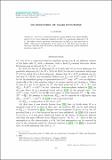Notice
This is not the latest version of this item. The latest version can be found at:https://dspace.mit.edu/handle/1721.1/135311.2
On induction of class functions
| dc.contributor.author | Lusztig, G | |
| dc.date.accessioned | 2021-10-27T20:22:54Z | |
| dc.date.available | 2021-10-27T20:22:54Z | |
| dc.date.issued | 2021-05-07 | |
| dc.identifier.uri | https://hdl.handle.net/1721.1/135311 | |
| dc.description.abstract | <p>Let <inline-formula content-type="math/mathml"> <mml:math xmlns:mml="http://www.w3.org/1998/Math/MathML" alttext="upper G"> <mml:semantics> <mml:mi>G</mml:mi> <mml:annotation encoding="application/x-tex">G</mml:annotation> </mml:semantics> </mml:math> </inline-formula> be a connected reductive group defined over a finite field <inline-formula content-type="math/mathml"> <mml:math xmlns:mml="http://www.w3.org/1998/Math/MathML" alttext="bold upper F Subscript q"> <mml:semantics> <mml:msub> <mml:mrow class="MJX-TeXAtom-ORD"> <mml:mi mathvariant="bold">F</mml:mi> </mml:mrow> <mml:mi>q</mml:mi> </mml:msub> <mml:annotation encoding="application/x-tex">\mathbf {F}_q</mml:annotation> </mml:semantics> </mml:math> </inline-formula> and let <inline-formula content-type="math/mathml"> <mml:math xmlns:mml="http://www.w3.org/1998/Math/MathML" alttext="upper L"> <mml:semantics> <mml:mi>L</mml:mi> <mml:annotation encoding="application/x-tex">L</mml:annotation> </mml:semantics> </mml:math> </inline-formula> be a Levi subgroup (defined over <inline-formula content-type="math/mathml"> <mml:math xmlns:mml="http://www.w3.org/1998/Math/MathML" alttext="bold upper F Subscript q"> <mml:semantics> <mml:msub> <mml:mrow class="MJX-TeXAtom-ORD"> <mml:mi mathvariant="bold">F</mml:mi> </mml:mrow> <mml:mi>q</mml:mi> </mml:msub> <mml:annotation encoding="application/x-tex">\mathbf {F}_q</mml:annotation> </mml:semantics> </mml:math> </inline-formula>) of a parabolic subgroup <inline-formula content-type="math/mathml"> <mml:math xmlns:mml="http://www.w3.org/1998/Math/MathML" alttext="upper P"> <mml:semantics> <mml:mi>P</mml:mi> <mml:annotation encoding="application/x-tex">P</mml:annotation> </mml:semantics> </mml:math> </inline-formula> of <inline-formula content-type="math/mathml"> <mml:math xmlns:mml="http://www.w3.org/1998/Math/MathML" alttext="upper G"> <mml:semantics> <mml:mi>G</mml:mi> <mml:annotation encoding="application/x-tex">G</mml:annotation> </mml:semantics> </mml:math> </inline-formula>. We define a linear map from class functions on <inline-formula content-type="math/mathml"> <mml:math xmlns:mml="http://www.w3.org/1998/Math/MathML" alttext="upper L left-parenthesis bold upper F Subscript q Baseline right-parenthesis"> <mml:semantics> <mml:mrow> <mml:mi>L</mml:mi> <mml:mo stretchy="false">(</mml:mo> <mml:msub> <mml:mrow class="MJX-TeXAtom-ORD"> <mml:mi mathvariant="bold">F</mml:mi> </mml:mrow> <mml:mi>q</mml:mi> </mml:msub> <mml:mo stretchy="false">)</mml:mo> </mml:mrow> <mml:annotation encoding="application/x-tex">L(\mathbf {F}_q)</mml:annotation> </mml:semantics> </mml:math> </inline-formula> to class functions on <inline-formula content-type="math/mathml"> <mml:math xmlns:mml="http://www.w3.org/1998/Math/MathML" alttext="upper G left-parenthesis bold upper F Subscript q Baseline right-parenthesis"> <mml:semantics> <mml:mrow> <mml:mi>G</mml:mi> <mml:mo stretchy="false">(</mml:mo> <mml:msub> <mml:mrow class="MJX-TeXAtom-ORD"> <mml:mi mathvariant="bold">F</mml:mi> </mml:mrow> <mml:mi>q</mml:mi> </mml:msub> <mml:mo stretchy="false">)</mml:mo> </mml:mrow> <mml:annotation encoding="application/x-tex">G(\mathbf {F}_q)</mml:annotation> </mml:semantics> </mml:math> </inline-formula>. This map is independent of the choice of <inline-formula content-type="math/mathml"> <mml:math xmlns:mml="http://www.w3.org/1998/Math/MathML" alttext="upper P"> <mml:semantics> <mml:mi>P</mml:mi> <mml:annotation encoding="application/x-tex">P</mml:annotation> </mml:semantics> </mml:math> </inline-formula>. We show that for large <inline-formula content-type="math/mathml"> <mml:math xmlns:mml="http://www.w3.org/1998/Math/MathML" alttext="q"> <mml:semantics> <mml:mi>q</mml:mi> <mml:annotation encoding="application/x-tex">q</mml:annotation> </mml:semantics> </mml:math> </inline-formula> this map coincides with the known cohomological induction (whose definition involves a choice of <inline-formula content-type="math/mathml"> <mml:math xmlns:mml="http://www.w3.org/1998/Math/MathML" alttext="upper P"> <mml:semantics> <mml:mi>P</mml:mi> <mml:annotation encoding="application/x-tex">P</mml:annotation> </mml:semantics> </mml:math> </inline-formula>).</p> | |
| dc.language.iso | en | |
| dc.publisher | American Mathematical Society (AMS) | |
| dc.relation.isversionof | 10.1090/ert/561 | |
| dc.rights | Article is made available in accordance with the publisher's policy and may be subject to US copyright law. Please refer to the publisher's site for terms of use. | |
| dc.source | American Mathematical Society | |
| dc.title | On induction of class functions | |
| dc.type | Article | |
| dc.relation.journal | Representation Theory of the American Mathematical Society | |
| dc.eprint.version | Final published version | |
| dc.type.uri | http://purl.org/eprint/type/JournalArticle | |
| eprint.status | http://purl.org/eprint/status/PeerReviewed | |
| dc.date.updated | 2021-05-24T16:36:27Z | |
| dspace.orderedauthors | Lusztig, G | |
| dspace.date.submission | 2021-05-24T16:36:28Z | |
| mit.journal.volume | 25 | |
| mit.journal.issue | 13 | |
| mit.license | PUBLISHER_POLICY | |
| mit.metadata.status | Authority Work and Publication Information Needed |
